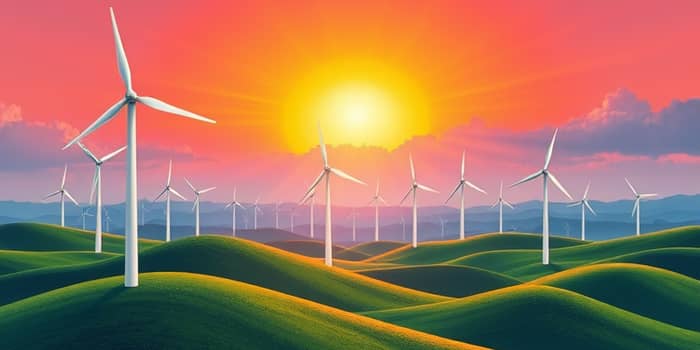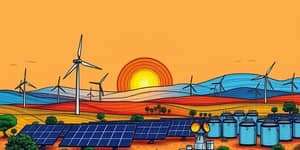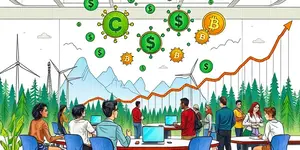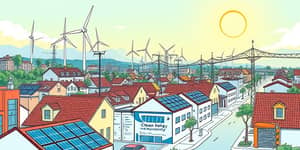The world is at a crossroads in how we generate and invest in energy. Over recent months, wind energy exchange-traded funds (ETFs) have captured investor attention with impressive gains. Yet amidst the optimism, questions linger: can these funds weather policy shifts, market volatility, and the test of time? This article explores the rise of wind energy ETFs, evaluates their resilience, and offers practical strategies for those considering a stake in the green revolution.
Understanding Wind Energy ETFs
Wind energy ETFs are specialized investment vehicles that pool capital to purchase stocks of companies involved in wind power generation, turbine manufacturing, and related services. Unlike broader clean energy ETFs, which might include solar, hydro, and geothermal assets, wind-focused ETFs zero in on a single pillar of the energy transition. This focus can offer rapid growth in clean energy exposure while also introducing unique concentration risks.
Investors choose ETFs for a host of reasons: cost efficiency, liquidity, and instant diversification. A wind ETF typically holds dozens of global companies, from European turbine giants to emerging North American project developers. By bundling these names into one tradable share, ETFs lower barriers to entry and simplify portfolio management.
Recent Performance and Trends
In the period spanning mid-2024 to mid-2025, wind energy ETFs have delivered noteworthy returns. For example, the TrueShares Eagle Global Renewable Energy Income ETF (RNWZ) surged 17.12%, while the First Trust EIP Carbon Impact ETF (ECLN) climbed 22.20%, though it spans all renewables. More focused options include:
Despite brief sell-offs following regulatory news, the underlying momentum remains positive. The broader clean energy index, led by solar and wind names, has seen volatile swings, but wind-focused funds have shown relative stability amid sector turbulence.
Drivers Behind the Surge
Several powerful forces have propelled wind ETFs upward. Understanding these global energy transition shift catalysts can help investors gauge the sustainability of current gains:
- Investor appetite for ESG and thematic products, with trillions seeking green exposure.
- Government commitments to decarbonization, including new offshore wind auctions in Europe and Asia.
- Advances in turbine efficiency, lowering levelized cost of energy and boosting project returns.
- tax efficiency benefits for investors offered by ETF structures compared to mutual funds.
Political Risks and Headwinds
No discussion of wind ETFs is complete without addressing regulatory uncertainty. In early 2025, the US Senate budget bill began phasing out many federal tax credits for wind projects, reducing financial incentives for developers. Although credits for nuclear, hydro, and geothermal energy persist until 2033, the shift increases near-term cost pressure on wind farms.
Policy reversals can trigger volatile policy-driven market swings, sending ETF prices tumbling in short order. Investors must be prepared for sudden shifts as elected officials debate subsidy frameworks and international bodies reassess climate targets.
Assessing Long-term Sustainability
Despite headwinds, several factors support wind energy’s enduring role in the global mix. To evaluate whether current ETF climbs are sustainable, consider these key trends:
- Ambitious decarbonization goals worldwide, such as the EU’s plan for a climate-neutral economy by 2050.
- Robust corporate procurement of renewable energy, with major tech firms signing long-term power purchase agreements.
- Growing public and private capital flows into climate finance, bolstering new project pipelines.
- strategic diversification across renewables insulates portfolios from single-sector shocks.
By blending wind ETFs with solar, storage, and broader clean energy funds, investors can harness the full spectrum of the transition while reducing idiosyncratic risk.
Practical Strategies for Investors
For those ready to explore wind ETFs, a disciplined approach can maximize opportunity and limit exposure. Here are actionable steps to build a resilient portfolio:
- Set a clear investment horizon—renewable infrastructure typically rewards patience over short-term trades.
- Compare expense ratios carefully; higher fees can erode returns, especially in niche funds like WNDY.
- Balance wind ETFs with broader clean energy and conventional assets to smooth volatility.
- Regularly monitor policy developments in key markets, adjusting allocations when incentives change.
- Consider dollar-cost averaging to mitigate the impact of sharp price swings.
By following these guidelines, investors align their strategies with the sector’s unique dynamics and position themselves for sustainable growth.
Expert Insights and Future Outlook
Leading analysts emphasize that wind energy remains a cornerstone of decarbonization. While solar often commands headlines, wind projects—both onshore and offshore—offer competitive costs and scalable capacity. As technology evolves, turbine sizes increase and installation methods advance, reducing barriers to entry in emerging markets.
Fund managers note that wind ETFs provide long-term sustainable investment growth by tapping into a multi-decade build-out. Even if credit support wanes, falling hardware costs and maturing supply chains can sustain healthy margins. Additionally, global diversification—in funds like FAN—mitigates country-specific policy risk.
Ultimately, investors who see wind energy as more than a trading theme but as a foundational shift in how humanity powers itself are most likely to reap rewards. By aligning financial goals with values, they not only pursue returns but also contribute to a cleaner, more resilient future.
In conclusion, wind energy ETFs have demonstrated powerful gains and remain underpinned by strong fundamentals. While volatility and policy risks cannot be ignored, a thoughtful, diversified approach offers a realistic path to capturing long-term benefits. As the global push for decarbonization accelerates, wind energy stands ready to transform both markets and our collective drive toward sustainability.
References
- https://www.nerdwallet.com/article/investing/clean-energy-etfs
- https://etfdb.com/etfs/industry/wind-energy/
- https://www.dividend.com/wind-energy-equity-etfs-and-funds/
- https://www.morningstar.com/etfs/arcx/fan/performance
- https://www.markets.com/research/energy-et-fs-to-watch-in-2025-icln-vanguard-energy-etf-xop-fif-pbw
- https://www.statestreet.com/ie/en/insights/etfs-2025-outlook
- https://www.vaneck.com/nl/en/sustainable-etfs/
- https://www.morningstar.com/funds/clean-energy-etfs-sink-following-senate-bill-announcement










